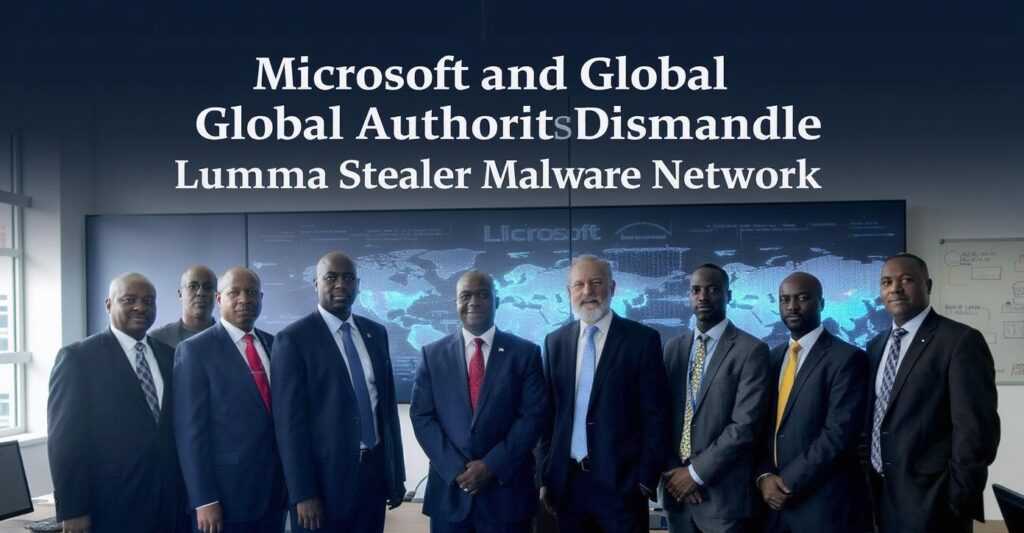In a landmark achievement in the ongoing fight against cybercrime, Microsoft and Global Authorities dismantle Lumma Stealer malware network, effectively eliminating a major threat that has been targeting users and organizations across the world. This collaborative effort between Microsoft, international law enforcement agencies, and cybersecurity experts marks a turning point in the global response to malware-as-a-service (MaaS) networks.
The takedown sends a strong message to cybercriminals that coordinated cybersecurity efforts can and will disrupt their operations. For organizations, it highlights the importance of proactive cybersecurity strategies and the value of threat intelligence in combating modern threats.
THE ORIGINS AND DANGERS OF LUMMA STEALER
Lumma Stealer emerged as a high-risk malware strain, sold widely on dark web marketplaces. Designed for ease of use and scalability, it enabled cybercriminals to steal sensitive data such as login credentials, browser cookies, crypto wallets, and financial information. As a MaaS platform, Lumma Stealer was offered on a subscription basis, allowing even non-technical users to launch data-theft campaigns with minimal effort.
The malware gained popularity due to its frequent updates, evasion techniques, and intuitive command-and-control interface. It used encrypted communication to exfiltrate data and often went undetected by traditional antivirus software. Lumma Stealer targeted both individuals and enterprises, making it a widespread cyber risk across industries.
The fact that Microsoft and global authorities dismantle Lumma Stealer malware network demonstrates that even sophisticated threats are not beyond the reach of collective action and technical innovation.
HOW MICROSOFT IDENTIFIED AND TRACKED LUMMA STEALER
Microsoft played a critical role in identifying the infrastructure and operators behind the Lumma Stealer operation. Leveraging its global security telemetry, Microsoft Threat Intelligence Center (MSTIC) and Microsoft Defender were able to trace the behavior of the malware across millions of devices.
Using AI-powered detection tools and behavioral analytics, Microsoft discovered the specific command-and-control patterns and data exfiltration methods used by Lumma Stealer. This intelligence was key to mapping out the full extent of the malware’s reach and feeding that data to law enforcement agencies.
Through Microsoft’s cloud-native security platforms such as Azure Sentinel and Microsoft Defender for Endpoint, cybersecurity professionals monitored infections in real time, collected forensic data, and issued alerts to affected users and enterprises.
This technical foundation made it possible for Microsoft and global authorities to dismantle Lumma Stealer malware network systematically and effectively.
GLOBAL COOPERATION AMPLIFIED THE TAKEDOWN EFFORT
What made this operation unique was the high degree of collaboration between Microsoft and multiple international law enforcement agencies, including Europol, Interpol, and cybercrime task forces from the United States, United Kingdom, Germany, India, and other countries.
Search warrants were executed, server infrastructures were seized, and arrests were made across jurisdictions. Investigators were able to locate and neutralize the command-and-control servers that enabled Lumma Stealer to operate at scale. Payment gateways used for subscription services on the dark web were also shut down.
The joint success where Microsoft and global authorities dismantle Lumma Stealer malware network highlights a model of public-private partnership that will be vital in tackling future cyber threats.
THE IMPACT OF LUMMA STEALER ON ENTERPRISES
Before the takedown, Lumma Stealer had infiltrated numerous enterprise networks, compromising employee credentials, business-sensitive data, and customer information. The malware’s reach was particularly severe in industries such as healthcare, banking, logistics, and e-commerce—sectors where the loss of data carries significant financial and regulatory implications.
Organizations affected by Lumma Stealer suffered reputational damage, compliance failures, operational downtime, and direct financial losses. Many companies discovered the infection only after their credentials were posted for sale on dark web forums.
This is why the action where Microsoft and global authorities dismantle Lumma Stealer malware network is viewed as a major relief for cybersecurity teams who had been working tirelessly to contain its damage.
THE TECHNOLOGICAL SOPHISTICATION OF THE MALWARE
One of the reasons Lumma Stealer was so challenging to deal with was its advanced structure. It employed sandbox evasion techniques, encrypted payloads, and anti-debugging mechanisms. Its code was modular, allowing cybercriminals to update functions or customize the malware based on campaign requirements.
Lumma Stealer used stealth mechanisms to avoid traditional security tools. Once executed, it embedded itself deeply into the operating system and harvested data periodically to minimize detection. Its communication to C2 servers was encrypted via HTTPS or even via Telegram APIs, further complicating its traceability.
Despite these challenges, Microsoft and global authorities dismantle Lumma Stealer malware network with precision and technical strength, disrupting a malware ecosystem that had been evolving for years.
MICROSOFT’S SECURITY INFRASTRUCTURE ENABLED FAST ACTION
Microsoft’s ability to act quickly was due in large part to its expansive and integrated security ecosystem. With over a billion devices under observation, Microsoft’s threat detection platforms offered visibility into attack patterns and malware behavior at scale.
Security analysts utilized Microsoft Defender for Endpoint to detect early signs of Lumma Stealer infections, while Microsoft Sentinel aggregated global telemetry to flag anomalies. Insights were fed into AI models that detected lateral movement and privilege escalation attempts within enterprise environments.
This fast detection loop allowed Microsoft to notify customers, isolate affected systems, and work with international partners to neutralize the threat. The success of this operation demonstrates why Microsoft and global authorities dismantle Lumma Stealer malware network in a timely and coordinated fashion.
A BLOW TO THE MALWARE-AS-A-SERVICE MARKET
Beyond the technical victory, this takedown significantly disrupted the MaaS ecosystem. Lumma Stealer had become one of the most commercially viable malware platforms, with thousands of paying subscribers across cybercrime forums.
By disabling the infrastructure and arresting those responsible, Microsoft and law enforcement agencies delivered a clear message: no malware operation is safe from scrutiny. The ripple effect has already been observed, with other MaaS operators going underground or halting operations to avoid detection.
Because Microsoft and global authorities dismantle Lumma Stealer malware network, future threat actors may hesitate before launching or monetizing similar platforms, knowing that consequences are imminent.
BUSINESS TAKEAWAYS AND CYBERSECURITY RECOMMENDATIONS
The takedown serves as a wake-up call for businesses, many of which continue to operate with outdated or fragmented security systems. The complexity of threats like Lumma Stealer requires organizations to adopt a proactive and layered cybersecurity approach.
Key recommendations include:
Adopting a zero-trust security framework
Continuously monitoring endpoints and network traffic
Conducting regular threat simulations and security audits
Training employees on phishing awareness and safe browsing
Investing in cloud-native security solutions with behavioral analytics
The scenario where Microsoft and global authorities dismantle Lumma Stealer malware network must inspire enterprises to act before the next generation of malware arises.
LOOKING AHEAD: WHAT THIS MEANS FOR CYBERSECURITY
While the operation against Lumma Stealer is a victory, it is also a reminder that cyber threats are constantly evolving. Cybercriminals are already exploring new platforms, encryption techniques, and AI-powered tools to bypass security systems.
Defending against future threats will require greater collaboration between technology providers, law enforcement, and enterprises. Microsoft has set a strong example by showing that when private sector resources and public sector authority unite, sophisticated malware networks can be dismantled.
With Microsoft and global authorities dismantle Lumma Stealer malware network, the cybersecurity world is reminded that vigilance, intelligence sharing, and timely action are our best defenses against cybercrime.
Read Full Article : https://bizinfopro.com/news/it-news/microsoft-and-global-authorities-dismantle-lumma-stealer-malware-network-2/
About Us : BizInfoPro is a modern business publication designed to inform, inspire, and empower decision-makers, entrepreneurs, and forward-thinking professionals. With a focus on practical insights and in‑depth analysis, it explores the evolving landscape of global business—covering emerging markets, industry innovations, strategic growth opportunities, and actionable content that supports smarter decision‑making.



